Marvelous Milkweed – Answers to 21 Common Questions
This post may contain affiliate links. Read my full disclosure here.
Milkweed is a “must have” for butterfly gardening, but the right milkweed plants are good for people, too. We’ll share answers to some of the most common questions about growing and using these beautiful native plants.

What is a milkweed plant good for?
Most people know that monarch butterflies rely on milkweed to survive, but these plants also provide food for many other insects.
Less known is that milkweed has a long history of use for food and medicine, which we’ll cover in the second half of the article.
What does milkweed look like?
There are over 2000 milkweed species worldwide, with a wide range of flower colors and growth habits. The three species below are widely available and adaptable to most areas.
Common milkweed (Asclepias syriaca) can be found throughout most of the central to eastern United States and Canada (see USDA range map below) and is native to North America.
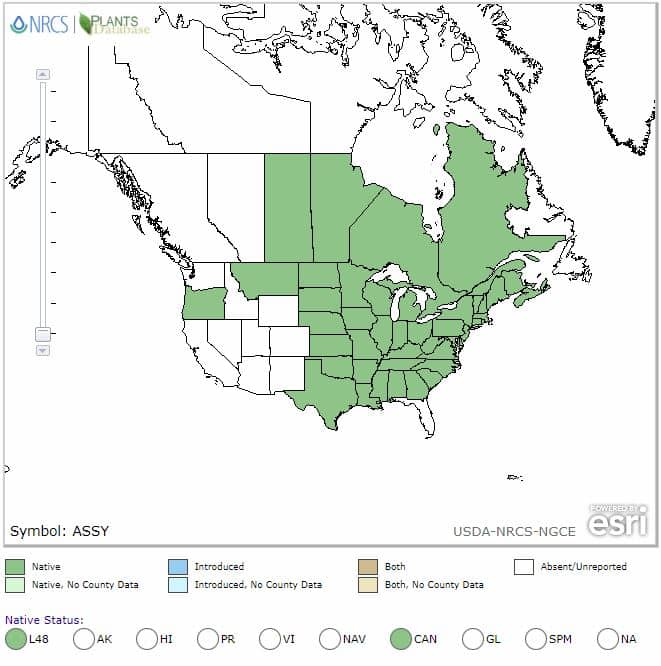
It likes dry, sunny, open places – like my yard and veggie garden – and farm fields, railroad edges, pastures and vacant lots.
Common milkweed plants grow from 2-5′ (60-150cm) in height. Their leaves are large (4-6″, 10-15 cm) and oval shaped with smooth edges, and are attached in opposing pairs on the stem. When a stem or leaf is damaged, they ooze large amounts of white, sticky sap.
Flowers are pastel pink, about 1/2″ (1cm) wide, and are found in clusters up to 2″ (5 cm wide). Each flower has 5 downward-pointing petals and a 5-part pointed crown (Wildflowers of Wisconsin). The flowers also smell quite lovely, very sweet but not cloying.
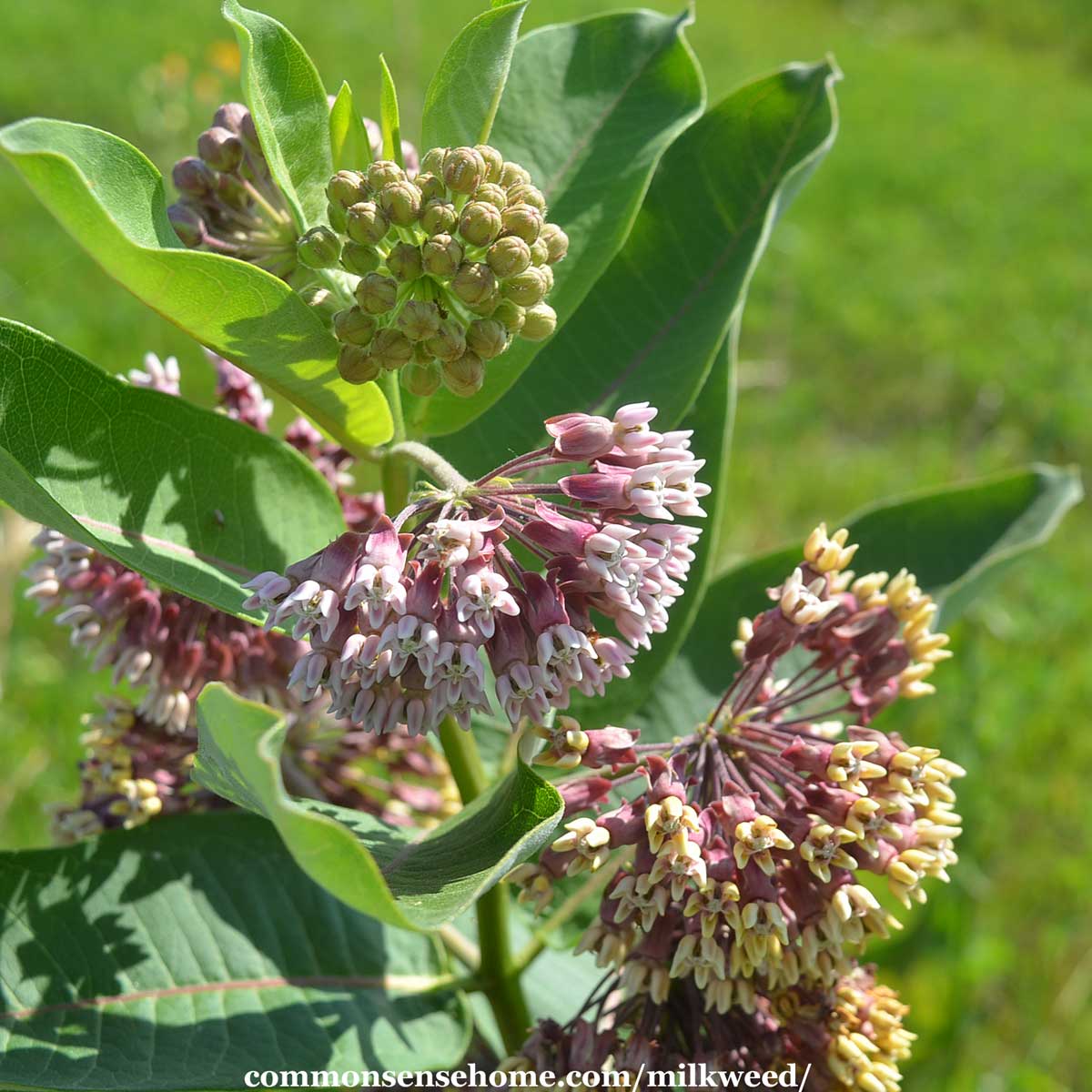
Swamp milkweed (Asclepias incarnata) grows from 1-4’ (30-120 cm) in height, and prefers moist conditions with full sun, such as stream edges and swamps, or a rain garden. See USDA range map.
The flowers are rosy red and white, and form several flat clusters at the top of the plant. They have the same five petal crownlike conformation as Asclepias syriaca flowers.
Seed pods and leaves are longer and narrower than Asclepias syriaca.
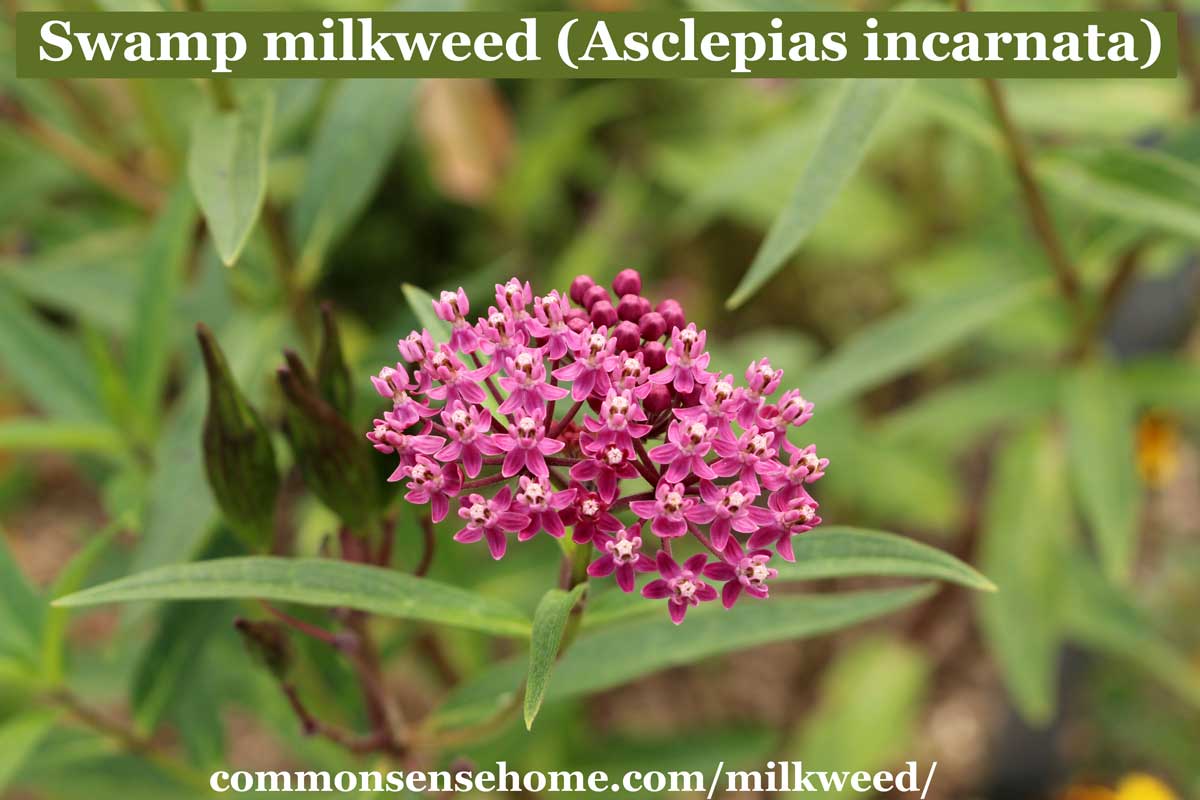
Butterfly milkweed (Asclepias tuberosa) has a bushy growth habit, topped with bright orange flower clusters. Leaves are lance shaped, 1 ½ to 2 ¼ inches long. The plant grows 1 ½ to 2 feet tall. See USDA range map.
Asclepias tuberosa is also known as pleurisy root, for its historical use treating chest ailments. It does not have milky sap. It’s also known as butterfly weed.

Which milkweed is best for monarchs?
Monarch caterpillars only eat milkweed. Eggs laid on other plant species = dead caterpillars. The life cycle of monarchs is completely dependent on milkweed.
The best milkweed for monarchs depends on where you are. Ideally, you want to rely on species native to your area. That way, you provide a natural food source for caterpillars and nectar source for adult butterflies. The Monarch Joint Venture website lists over two dozen milkweed species, sorted by region, to help you find the best milkweed for your yard.
One note: tropical milkweed is not native to the United States, but has naturalized in some southern states. It’s best to clip back the blossoms of this plant in winter if it grows in your area of the U.S., to encourage butterflies to follow their natural migration patterns.
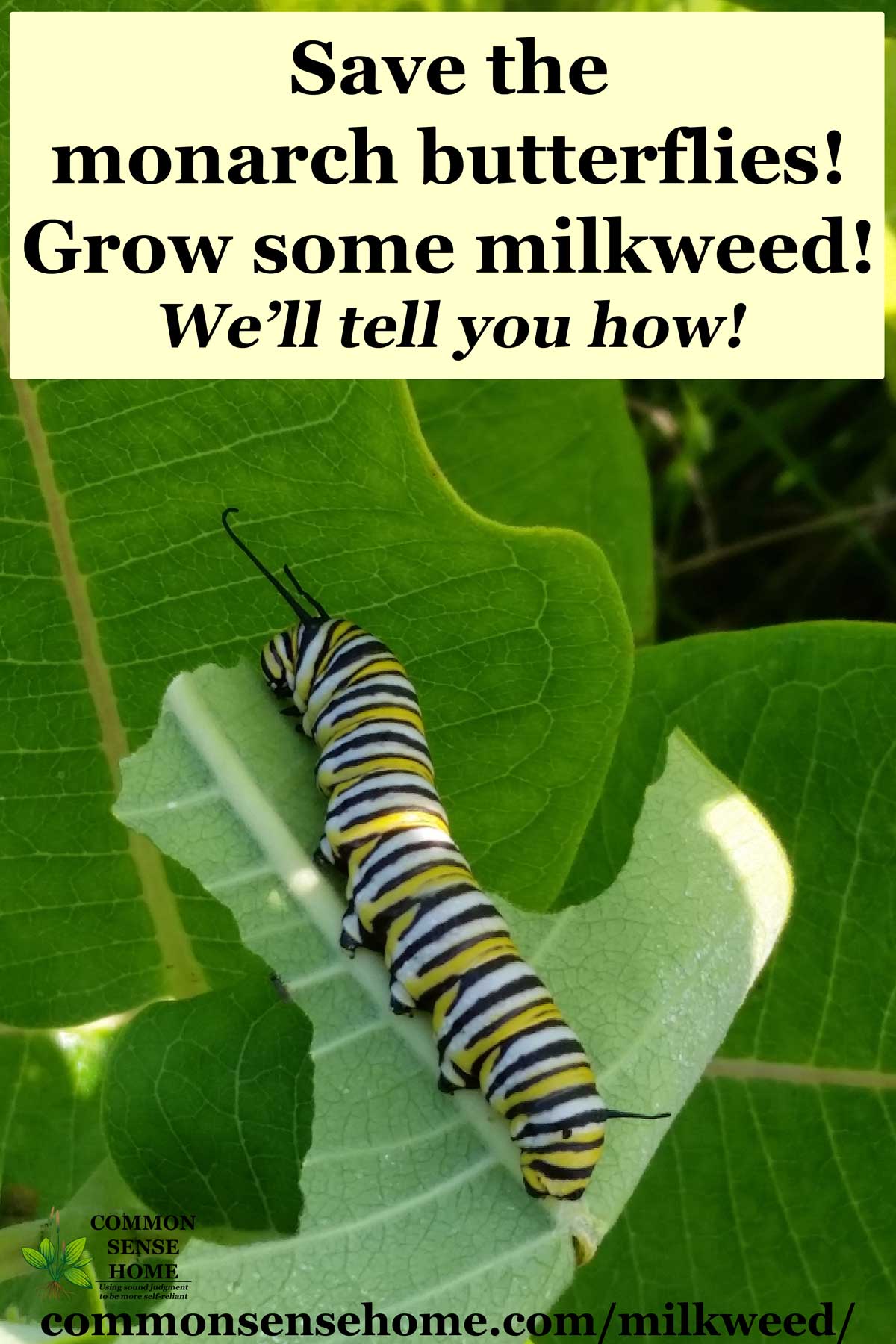
Do Asclepias species need full sun?
Yes, these flowers do best in full sun, but may tolerate partial shade. Once established, the plants are normally easy to grow.
Is milkweed a perennial?
Yes, milkweeds are perennials, although some species are not frost tolerant and will die off in cold climates.
Will it survive the winter?
Cold hearty Asclepias species die back to their roots over winter and sprout new growth in spring. The dried seed pods add interest to the winter landscape.
Will milkweed grow back?
As noted above, the cold hearty milkweed species die back to their roots and then re-emerge in spring. Heck, I have random milkweed plants pop up all over my yard – even inside my greenhouse.
Heat loving species like tropical milkweed will not grow back.
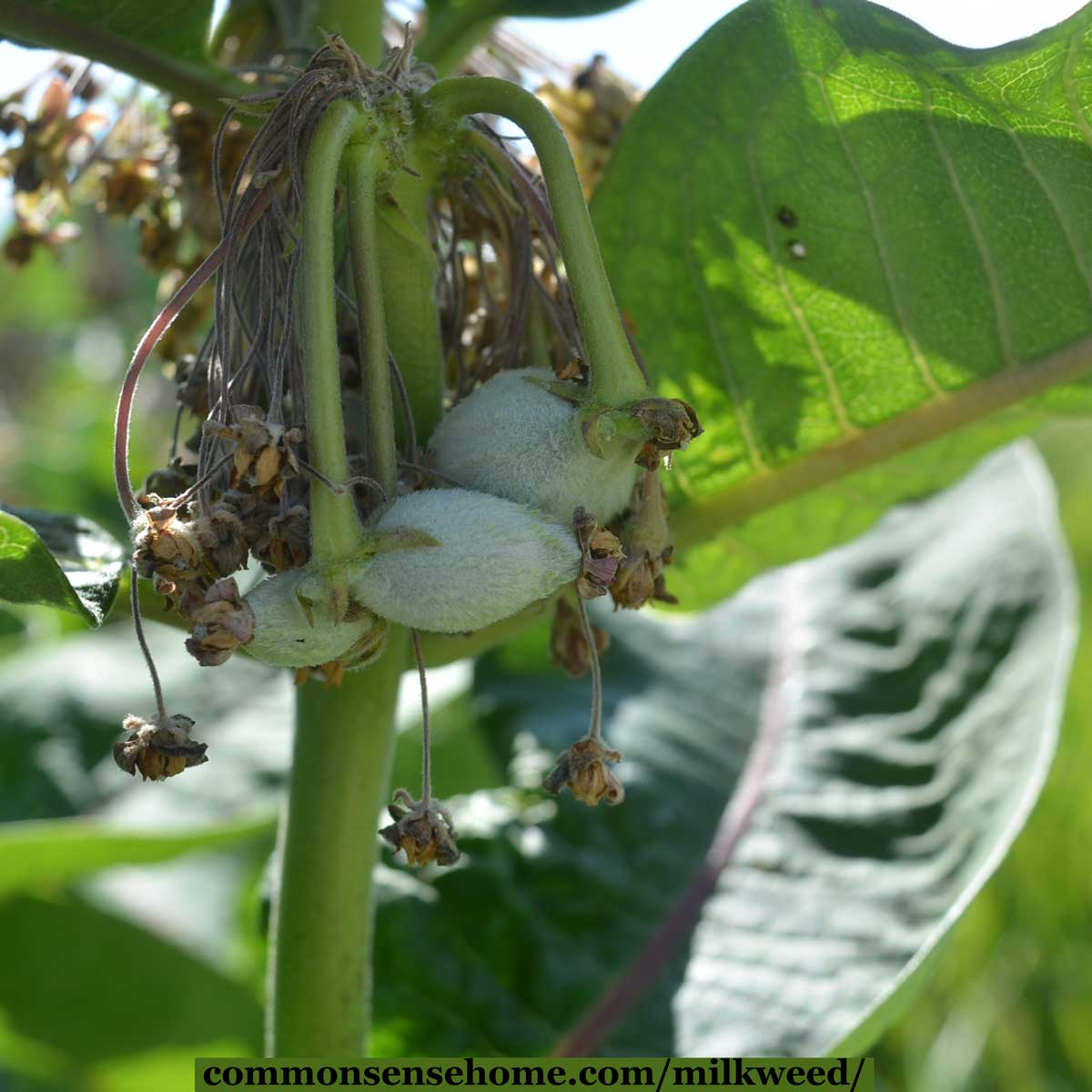
When should you plant milkweed?
Milkweed seeds require cold stratification, i.e., the seeds need to be chilled before they sprout.
This gives you two options:
- Wrap seeds in a damp paper towel. Place them in a container in the refrigerator for several weeks.
- Plant them in fall and let Mother Nature do the work.
If seeding outdoors, prep the seed bed as you would for other garden crops. The best time to plant milkweed seeds is after fall temps are too cold for germination. Scatter seeds onto the soil, covering only lightly. Watch for emergence in spring.
If starting seeds indoors, plant in regular potting soil (after cold treatment), scratching the seeds lightly into the top of the soil.
How do you transplant common milkweed?
Transplanting is best accomplished in spring, when the plants are still small and temperatures are moderate. Simply dig up a section of plants (do your best to include plenty of roots), and relocate in your preferred spot.
Do you cut back milkweed in fall?
You can cut the plants back, but prefer to leave them to mark the patch. They also provide visual interest in the landscape, and some insects eat the seeds.
Do milkweed plants spread?
YES! Milkweed can spread via their rhizomes (roots) and via seeds, so if you need to control the size of your patch, go ahead and remove the seed pods. You may also want to plant in a pot rather than directly in the soil, or plant the plant in an area where it has room to spread.
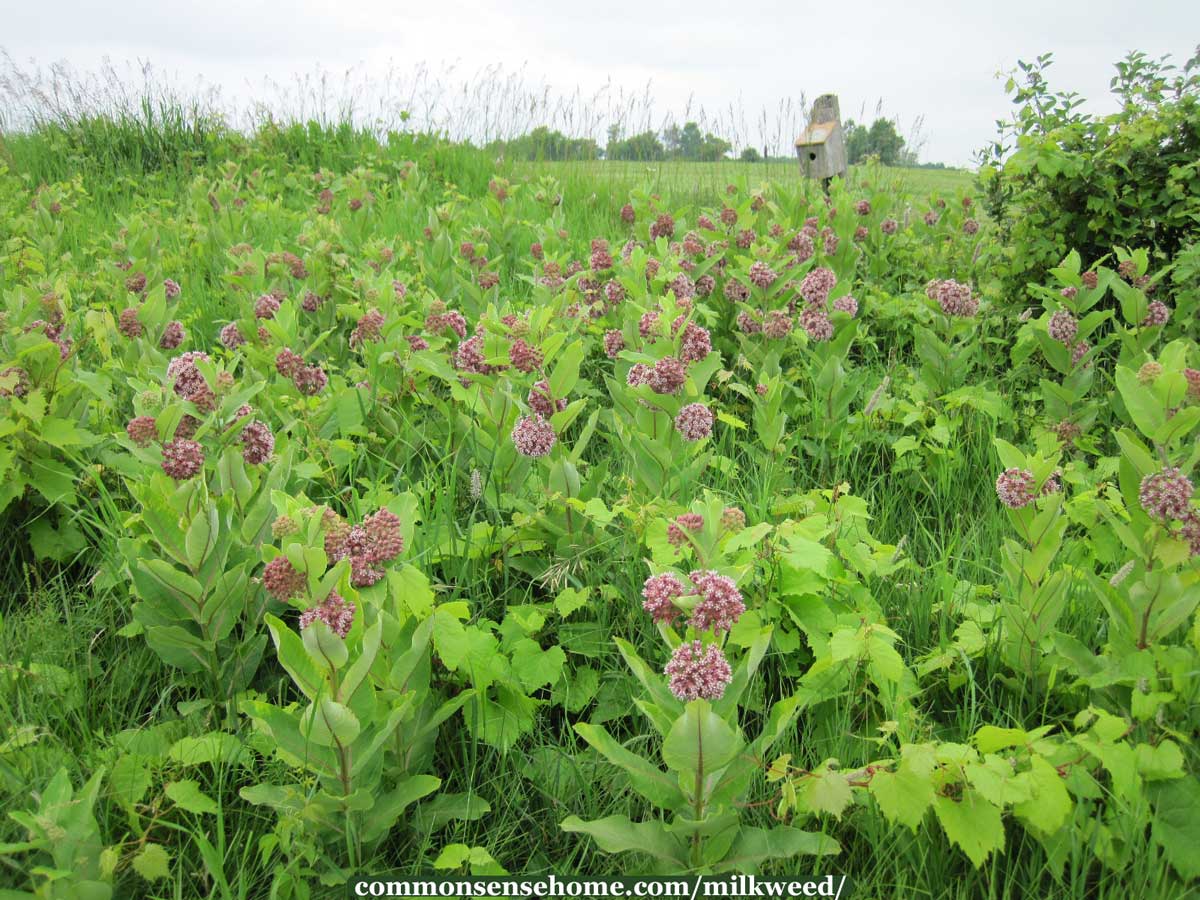
Should I deadhead or trim back milkweed?
It’s okay to deadhead milkweed as the flowers fade to prolong blooming. Similarly, if you cut back the shoots on common milkweed, it will grow young, tender shoots, which are preferred caterpillar food.
Don’t go overboard with trimming. Remember, the mature butterflies relay on milkweed flowers for their nectar.
Seed pods form in fall. They are long, green and somewhat spiky. As they ripen, these pods turn pale brown, split open, and release seeds attached to silky, hair-like fuzz that carries the seeds on the wind.
How do I get rid of milkweed naturally?
If milkweed is taking over your garden, rototilling is the worst thing you can do. The plants spread from the roots, so this will make the problem worse.
Instead, start at the edges of the cluster and work your way in, digging and removing roots as you go.
Regular mowing can help keep a patch from spreading, but is best combined with fall root removal to clear the plants entirely.
Don’t allow plants to seed out in the garden if you need to limit their spread. Remember, milkweed grows from seeds and roots.

Is milkweed poisonous if you touch it?
Milkweed contains cardiac glycosides in the sap, which can cause skin irritation in sensitive individuals. It’s best to wash your hands after exposure.
Would you like to save this?
The amount of these compounds varies within the species, and from plant to plant based on growing conditions.
Can milkweed blind you?
It’s possible that sap rubbed into the eye may cause temporary loss of vision. Don’t rub sap in your eyes.
Is milkweed toxic to dogs? What about livestock and other animals?
Yes. Don’t let dogs eat raw milkweed. Most dogs won’t eat it, but some like to chew on everything.
Grazers typically avoid milkweed unless there is nothing else to eat. Cooking breaks down the problematic compounds.
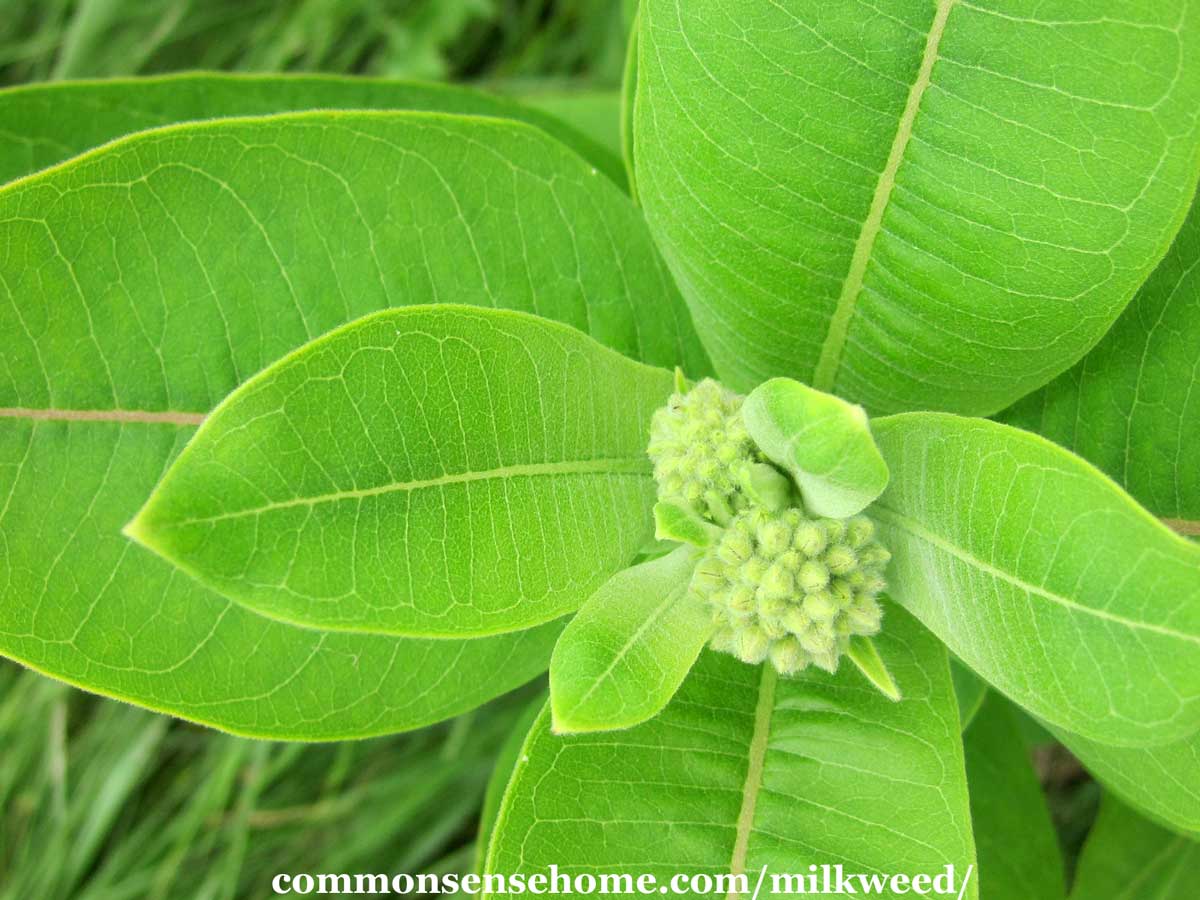
What animals eat milkweed?
Common milkweed provides food for many different types of insects, both through its nectar and its leaves. IllinoisWildflowers.info gives a long list of critters that use milkweed as a host plant:
The flowers are very popular with many kinds of insects, especially long-tongued bees, wasps, flies, skippers, and butterfly species, which seek nectar. Other insect visitors include short-tongued bees, various Milkweed plant bugs, and moths, including Sphinx moths.
Some of the smaller insects can have their legs entrapped by the flowers and die. Common Milkweed doesn’t produce fertile seeds without cross-pollination.
The caterpillars of Monarch Butterfly feed on the foliage, as well as the caterpillars of a few moths, including Milkweed Tiger Moth, Unexpected Cycnia, and Delicate Cycnia.
Many milkweed eating insects are brightly colored. This warns potential predators of the toxicity that they acquired from feeding on milkweed.
Orioles use old stem fibers for making nests.
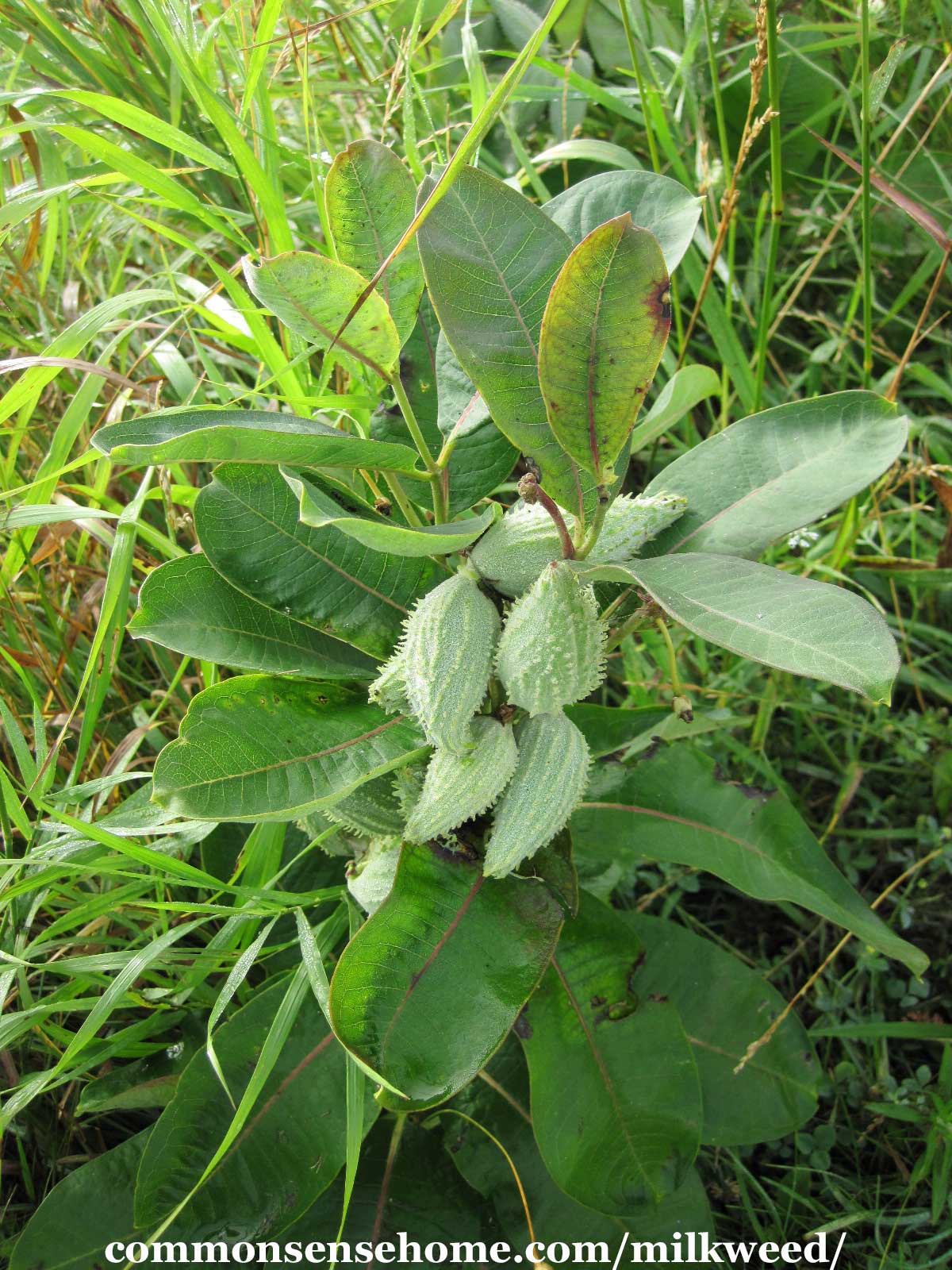
Is milkweed edible for humans?
The leaves, new shoots, flower buds and firm seed pods of the common milkweed (Asclepias syriaca) are all edible. Not all milkweed species are edible, so make sure you have a positive ID. Always test a small sample of a new wild food before consuming in quantity.
Gather leaves and shoots in early spring when they first appear. Gather seed pods in late summer.
In The Forager’s Harvest, Samuel Thayer states that: “Common milkweed has one of the mildest, neutral and agreeable flavors of any vegetable you’ll ever find, wild or cultivated.”
While I haven’t always agreed with Mr. Thayer’s flavor descriptions, at the very least the plant is certainly generally safe to eat in moderate quantities. The preparation instructions below are adapted from The Forager’s Harvest, which I recommend for anyone interested in foraging wild edibles.
Shoots
Milkweed shoots appear asparagus-like, except they have a few pairs of small leaves clasping their sides. The smaller the shoots are, the better they taste. They are edible as long as they bend easily and break off when pinched. Normal size is three to six inches.
Just boil the shoots in salted water until they are tender, which is usually twenty minutes or so. (Cook all milkweed parts in roughly the same manner.) Despite the rather long cooking time, these shrink far less than most green vegetables.
The flavor of milkweed shoots is similar to asparagus or green beans. As the plants grow taller, you can still eat them, using only the top few inches and removing all but the smallest leaves. At this stage they are never quite as good as the younger shoots.

Flowers
Gather unopened flower buds in midsummer. They look like miniature heads of broccoli but are softer. Dice up a small handful of these and toss them into a soup, casserole, pasta dish, stuffing, or stir-fry to excellent effect. To eat larger servings of the flower buds alone, boil them, drain the water, and season.
Be careful to check buds for baby monarch caterpillars before harvesting.
Pods
Milkweed pods are excellent in stew, stir-fry, or eaten as a vegetable side dish. They are delicious with cheese and bread crumbs.
The best time to gather milkweed pods is late summer (from early August to early September around here). The size of the pods varies greatly from one plant to the next. An immature pod on one specimen may be larger than a full-grown pod on another, so determining which pods are immature can be tricky.
The pods that are too old tend to be rougher on the outside than the young pods. They also tend to have more pointed, curved tips. These are tendencies, not rules.
There is a line running the length of each pod, along which it will split open to release its seeds when mature. If you pull apart on both sides of this line and it splits open easily, the pod is probably too old to use.
For the beginner, it is best to open up several pods and examine the insides to get an idea of which ones are in the proper stage for harvesting. In an immature milkweed pod (one good for eating) all of the seeds are completely white, without even a hint of browning.
The silk should be soft and juicy, not fibrous. It should be easy to pinch through the bundle of silk or to pull it in half. Immature pods are also plumper and harder than mature ones.
Cook milkweed pods within a few hours of picking. Leave them sit in the refrigerator for a day and they become tough and inedible. Boil and freeze pods for longer storage.
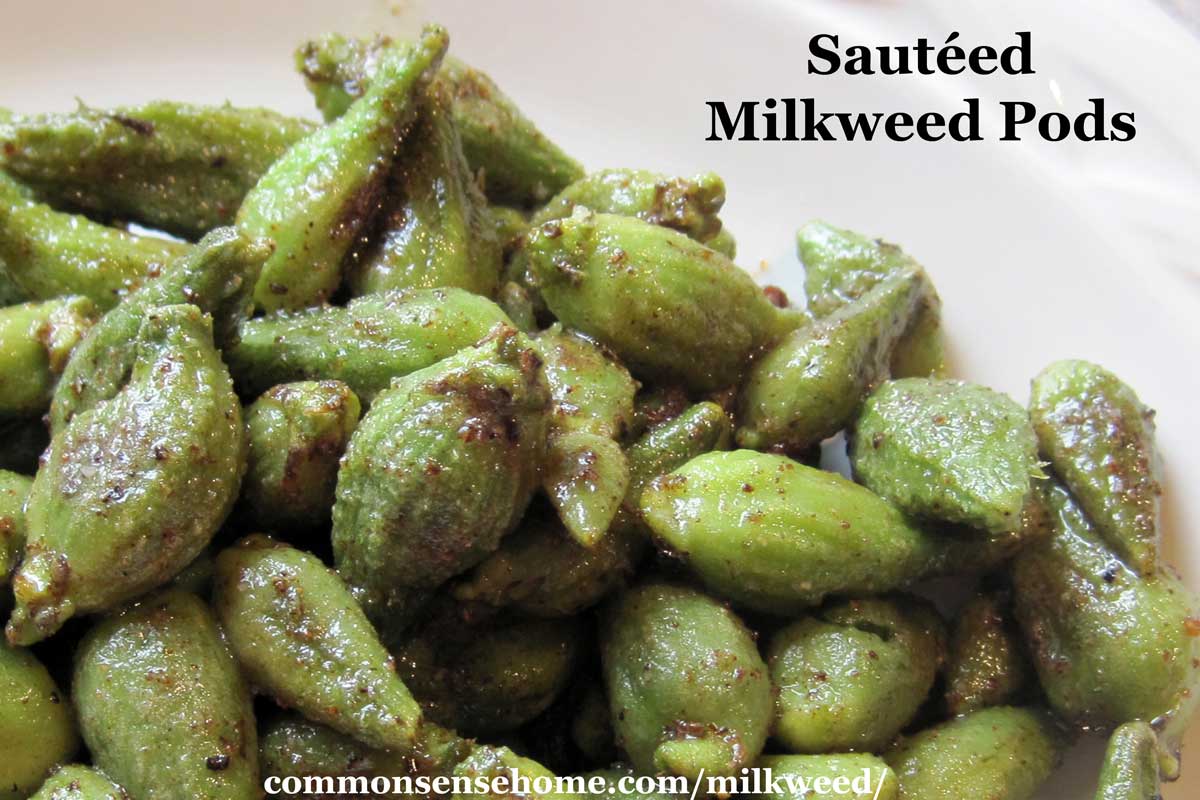
Do the Plants Have Medicinal Uses?
Note: Please exercise caution when using this or any other wild plant internally. The post is for general information only and is not meant to diagnose or treat any illness.
The book Edible and Medicinal Plants of Minnesota and Wisconsin lists a long history of medicinal uses of common milkweed (Asclepias syriaca).
Conditions treated include:
- Warts (sap)
- Ringworm (sap)
- Poison Ivy Rash (sap)
- Athlete’s Foot (stems/sap)
- Asthma (roots)
- Lung Infections (roots)
- Cough (flowers)
- Gallstones (roots)
- Edema (roots)
- Dropsy (roots)
- Rheumatism (roots)
- Parasites (leaves)
- Syphilis (leaves)
- Venereal Diseases (roots)
The text includes summaries of the treatment methods, with links to sources for additional information.
Are there other ways to use Common Milkweed?
Candle wick made of milkweed silk burns cleaner than a wick made of cotton. During WWII, milkweed pods were gathered for their silk to make filling for life preservers.
W.I. DeWees, an assistant professor of agriculture from Illinois State Normal University, was state superintendent for the floss collection program. With labor – both in the city and countryside – at a premium, schoolchildren were enlisted in the cause. This was a time before the complete mechanization of the farm and school consolidation, so there were many more children and many more schools in the Illinois countryside than today.
Therefore, it was schoolchildren who spent the untold hours walking fencerows, roadsides and railroad right of ways looking for milkweed, which before the war was considered little more than a weed.
Onion sacks were distributed to carry the collected pods, and children received 15 cents per bag, with an additional 5 cents if the pods were dried. Two bags of pods contained floss for one life jacket. The U.S. military called for the collection of 2 million pounds of floss nationally, enough to fill 1.2 million life jackets.
Harvesting the floss was simply a matter of picking the pods before they cracked open and released their seeds. Consequently, the pods doubled as handy storage units before the naturally buoyant fiber could be processed into lifejacket stuffing.
Read the full story at Pantagraph.com.
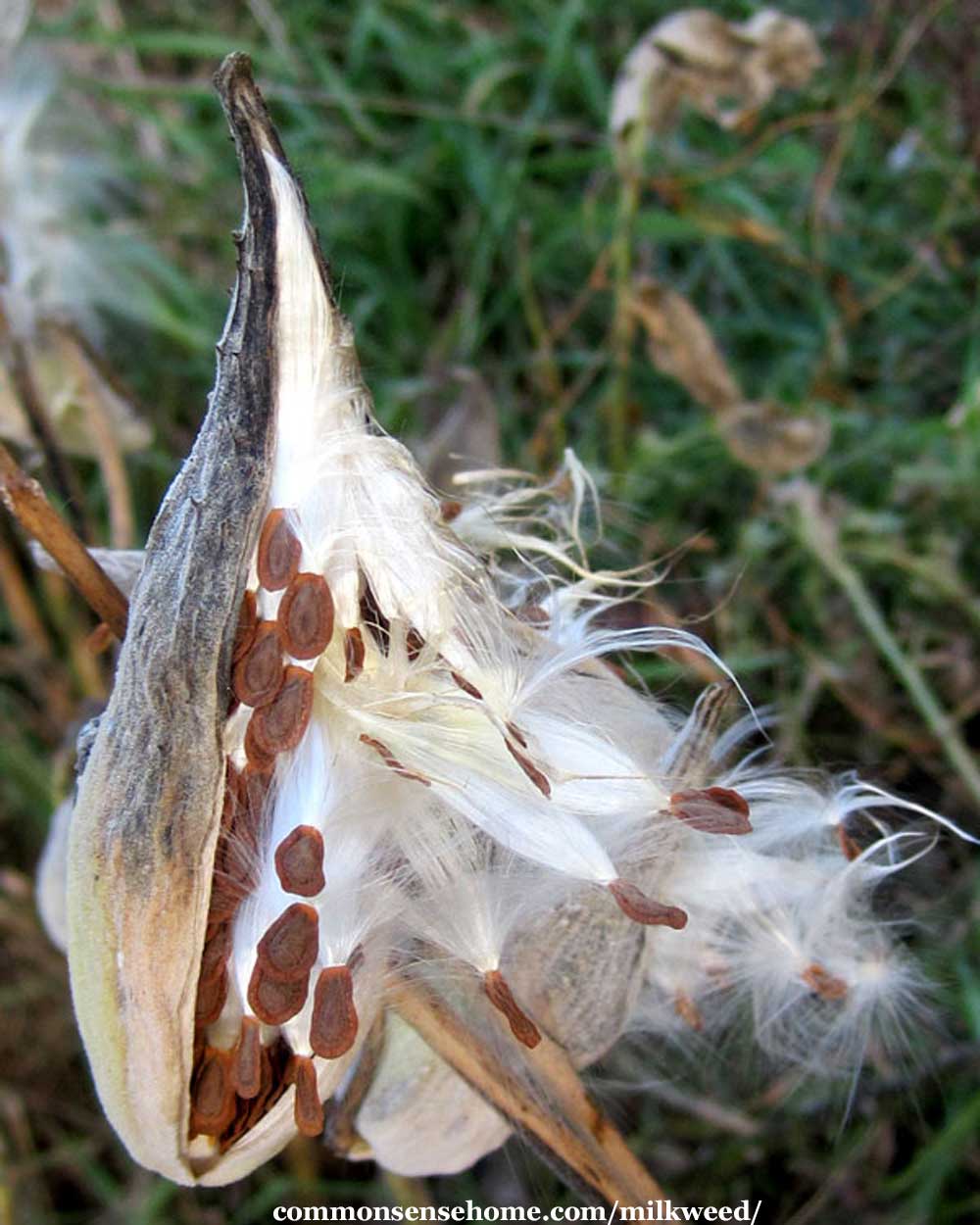
Learn How to Use Wild Plants
Weeds are survivors, and often thrive where more domesticated crops fail. Learning to appreciate them is long overdue.
Many of these plants people now try to eradicate have a long history of use for food and medicine. I encourage you to check out the full Weekly Weeder series, and see what useful plants you have in your own backyard.
Some of the articles include:
- Common Blue Violet – Soothing Medicine Inside and Out
- Creeping Charlie – Use and Control of the Shade Loving Groundcover
- Benefits of Dandelion – Plus How to Use the Greens, Seeds, Roots and Flowers
Thanks for taking the time to visit, and I hope you’ll be back again soon. As always, if you’ve enjoyed the post, please pass it along.
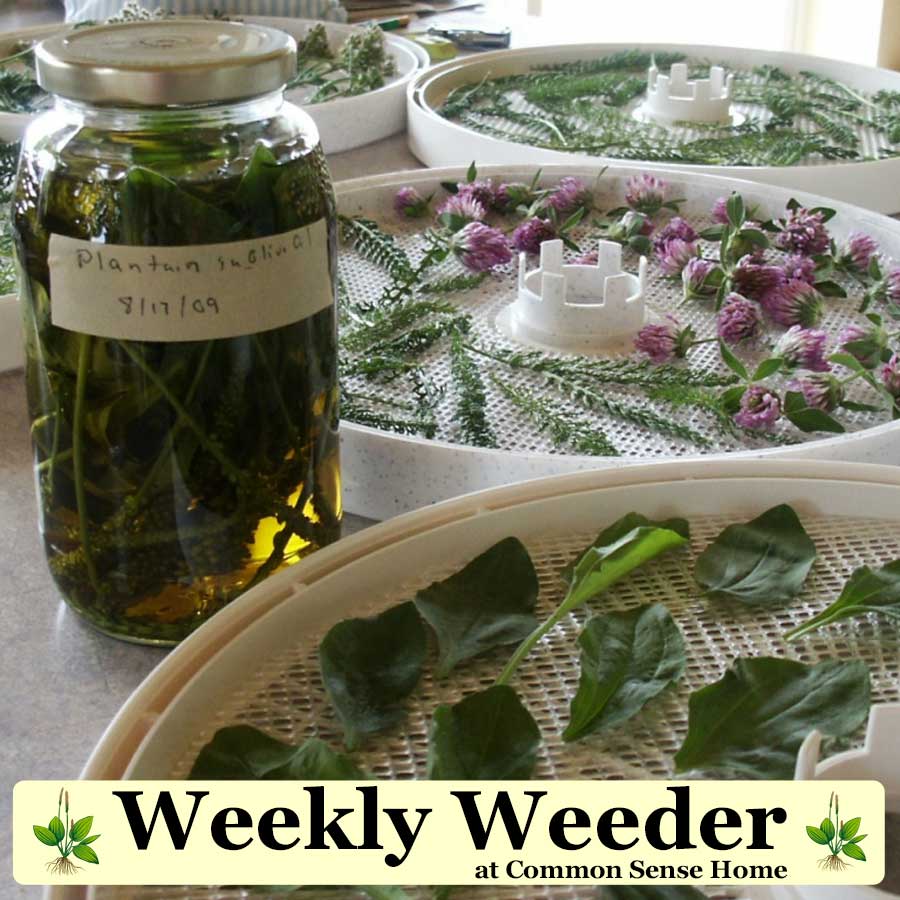
Originally posted in 2011, updated in 2019.

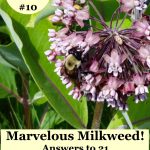
I have a horrible infestation of aphids! Yellow little buggers??
I have had lady bugs the last three years that have kept the infestation down. But this year my supplier was unable to get the lady bugs for me. I’ve sprayed them off with water and sprayed them with soapy water. Still there. Help??!!
Aphid traps?
Can you use milk weed sap on poison ivy rash? If so, what kind of milkweed and how do you use it
I don’t think that’s a good idea.
Milkweed sap is a natural latex, so you’d be trapping the irritation, not soothing it.
I’d try plantain, jewelweed or chickweed instead.
My milkweed bloomed way too early this year. It’s just not even the middle of July and I have large pods. The Monarch’s have just arrived. What do I do to prevent this for occurring next year? Would they have re-bloomed if I had cut them when the bloom was at the end?
If you cut back young shoots (to delay flowering), more will grow. I’m not sure how late in the growth cycle you can clip back and still get new growth. I still see new hoot coming up here, even though some plants are in full flower.
If you have a lot of plants, you could try cutting back some of the patch and see if there is still new growth, even though many of the pods have already filled out.
Looking for a simple ” seed wart”.. remedy for a friend and ran across this site…
i absolutely have been stuck ..(in a good way) here going from one remedy to another 🙂 re: Dandelion.Milkweed etc..
Any good news on Aloe Vera for such warts??
Thanks so much Laurie ..
..i Bet you get many happy subscribers!.
.(im waiting for you too reply humbly stating…….”Awww… NEVERMAN! ) HENCE a play on your Lastname..
Ohhh..Nevermind…Neverman lol . ..well..it did play out far smoother in my head lol.! Xoxo melissa “honeybee” and flower!!! “Stillman”
I do have a post dedicated to home remedies for warts, and milkweed and aloe vera sap are both commonly used remedies.
Hi, Thank you for the interesting article on milkweed. Our family has a traditional maple sugaring operation in central Vermont. Would you be willing to refer our website as a source for pure maple syrup, and our facebook page, sillowaymaple as a source of ongoing commentary, recipes, and daily maple related activities? Or invite your readers to “like” our page? Thank you, Bette Lambert
Bette, I’ll Pin your site and be contacting you directly via email.
Thanks for the great article on Milkweed. I never knew portions of the plant were edible. The flower bud sounds like my most logical selection as a first time eater. I use the sap on warts which seems to help somewhat. I normally drip the sap into a container holding castor oil. I then mix it and mix it and keep doing it till the sap has broke down. I add a few drops of tea tree oil & plantain oil to the mixture.
Thanks for sharing your home remedy.
Thanks for stopping by, and for taking the time to comment.
Great info, thanks for sharing.